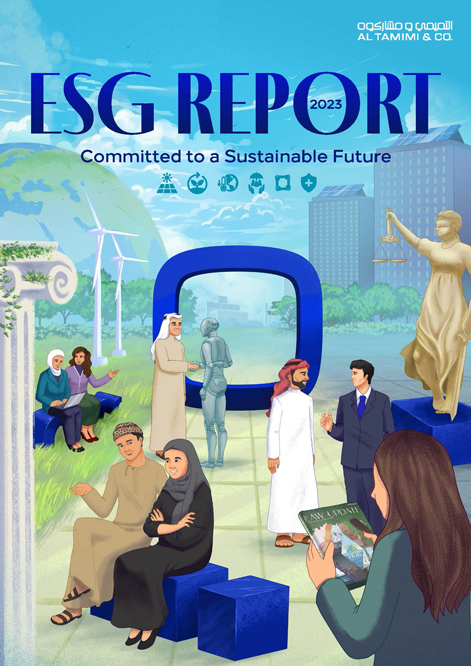- Arbitration
- Banking & Finance
- Capital Markets
- Commercial
- Competition
- Construction & Infrastructure
- Corporate / Mergers & Acquisitions
- Corporate Services
- Corporate Structuring
- Digital & Data
- Dispute Resolution
- Employment & Incentives
- Family Business
- Innovation, Patents & Industrial Property (3IP)
- Insurance
Find a Lawyer
Book an appointment with us, or search the directory to find the right lawyer for you directly through the app.
Find out more
Committed to a Sustainable Future
We are excited to unveil our inaugural Environmental, Social, and Governance (ESG) Report, highlighting our dedication to responsible and sustainable business practices.
From our efforts on cutting carbon emissions to promoting diversity and inclusion initiatives, offering pro bono legal aid, and aiding local communities, each initiative underscores our profound commitment to fostering positive change in our communities and beyond.
Delve into our journey of progress and future aspirations.
Read Now
The leading law firm in the Middle East & North Africa region.
A complete spectrum of legal services across jurisdictions in the Middle East & North Africa.
-
Practices
- All Practices
- Banking & Finance
- Capital Markets
- Commercial
- Competition
- Construction & Infrastructure
- Corporate / Mergers & Acquisitions
- Corporate Services
- Corporate Structuring
-
Sectors
-
Country Groups
Today's news and tomorrow's trends from around the region.
17 offices across the Middle East & North Africa.
Our Services
 Back
Back
-
Practices
- All Practices
- Banking & Finance
- Capital Markets
- Commercial
- Competition
- Construction & Infrastructure
- Corporate / Mergers & Acquisitions
- Corporate Services
- Corporate Structuring
- Digital & Data
- Dispute Resolution
- Employment & Incentives
- Family Business
- Innovation, Patents & Industrial Property (3IP)
- Insurance
- Intellectual Property
- Legislative Drafting
- Private Client Services
- Private Equity
- Private Notary
- Projects
- Real Estate
- Regulatory
- Tax
- Turnaround, Restructuring & Insolvency
- White Collar Crime & Investigations
-
Sectors
-
Country Groups
- Law Firm
- /
- Insights
- /
- Law Update
- /
- August 2016
- /
- Eureka! Monetising Research in the Education Sector
Eureka! Monetising Research in the Education Sector
Ahmad Saleh
August 2016
Technology Transfer
The process through which an academic idea is transferred to industry and commercialised is known as “technology transfer.” In order to ensure those that come up with the big ideas are properly rewarded, the rights to the research or technology should be appropriately protected. To this end, patent protection is what is generally required to protect creations of a technical nature. In certain countries, this protection may extend to processes executable on computer devices, such as through computer software and programs. For example, the precursor to the Microsoft Excel spreadsheet was famously not patent protected (for a number of legal reasons), resulting in the rapid exploitation of the software.
Patent protection can be sought early in the creation process, even when the academic research has not yet matured into a prototype or final commercial product.
Publish and Perish
In science and engineering faculties, academics primarily get recognised through research activities. The recognition and accreditation of a faculty normally requires the publication of research results in specialised journals. It is very tempting for academic staff to publish their research results as quickly as possible, and is sometimes done without regard to the consequences of patent protection.
However, patent protection should be considered very early on in the process, and especially before any publication of the academic research; otherwise, the novelty of the underlying invention may be destroyed, and the possibility of obtaining patent protection compromised.
Some countries, such as the United States, provide a grace period for applying for patent protection after publication by the inventor. Such a post-disclosure grace period is not available in the six-nation Gulf Cooperation Council, and it is therefore essential to apply for patent protection before any disclosure of the invention – and only the owner of patent rights can apply for this.
The time period between filing a patent application and getting the patent examined and granted could take a couple of years, depending on the country. During this period, however, the right to the invention is secured under a “patent pending” status, and publication of the invention can be made without risk, so the key step is to file.
GCC position
The rules of patent ownership vary from one country to another. Within educational institutions in the United Arab Emirates, the default rule in patent ownership is that the patent rights belong to the university. Otherwise, if the invention has an economic value ‘beyond the expectations’ of the parties when they signed the employment contract, then the employee inventor shall be entitled to additional compensation (to be decided by the court).
It therefore goes without saying that careful consideration by the employer is crucial in drafting employment contracts for research staff; the scope of employment should be sufficiently defined, so that any invention arising from that work falls clearly within the scope, and is not ‘beyond the expectations’ of the parties such as to jeopardise the academic institution’s ownership rights.
Stay updated
To learn more about our services and get the latest legal insights from across the Middle East and North Africa region, click on the link below.


